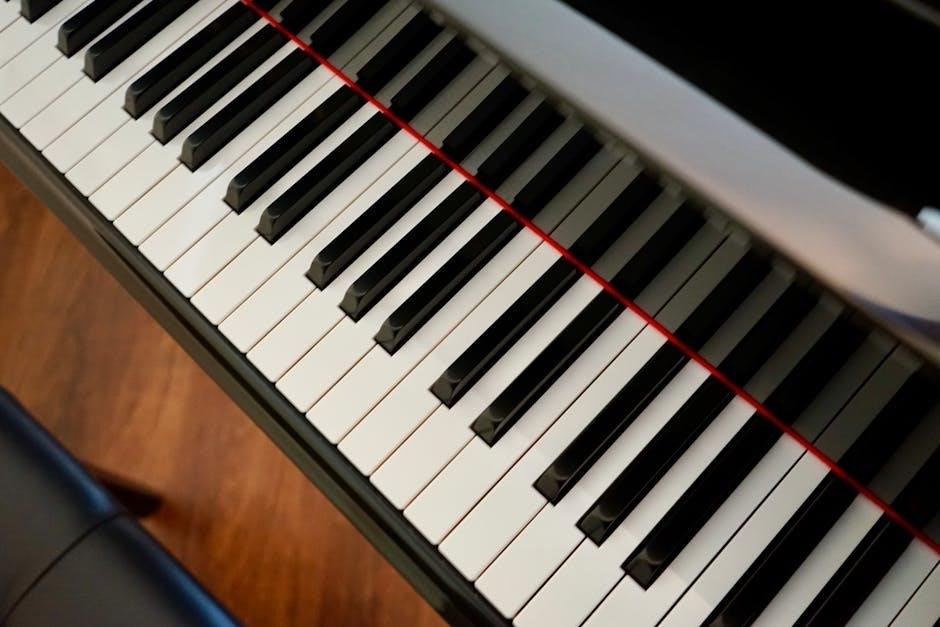Piano Chords PDF: A Comprehensive Guide

Unlock your musical potential with our comprehensive guide to piano chords! This resource offers a pathway to mastering a vast library of chords, enhancing your playing across diverse musical styles. Download our free PDF chord charts and begin exploring the world of harmony on the piano today.
Piano chord charts are invaluable tools for musicians of all levels, from beginners taking their first steps to seasoned professionals seeking a quick reference. These charts offer a visual representation of various chords, displaying the notes that comprise each chord and their corresponding positions on the piano keyboard. A chord chart acts as a roadmap, guiding your fingers to create harmonious sounds.
For beginners, piano chord charts provide a foundation for understanding basic chord structures and learning how to form them accurately. These charts eliminate the guesswork, allowing learners to quickly grasp the relationships between notes and chords. As you progress, chord charts become essential for exploring more complex harmonies, inversions, and voicings.
Piano chord charts come in various formats, including printable PDFs and interactive online tools. These resources often categorize chords into major, minor, seventh, diminished, and augmented types, offering a comprehensive overview of chord possibilities. Whether you’re practicing at home or performing on stage, a piano chord chart serves as a handy reference, ensuring you never miss a beat.
With a readily available piano chord chart, you can effortlessly learn new songs, experiment with chord progressions, and develop your improvisational skills. Embrace the power of visual learning and unlock the secrets of piano harmony with the help of these essential guides.
Benefits of Using a Piano Chord Chart

Piano chord charts offer numerous benefits for musicians of all skill levels. For beginners, they provide a visual and easily accessible way to learn and memorize fundamental chords. By clearly displaying the notes and finger positions, chord charts eliminate confusion and accelerate the learning process. This allows beginners to quickly start playing simple songs and chord progressions, fostering a sense of accomplishment and motivation.
More experienced players also find chord charts incredibly useful. They serve as a quick reference for unfamiliar chords or complex voicings, saving time and effort during practice and performance. Chord charts are also excellent tools for exploring new chord progressions and experimenting with different harmonic possibilities. They can inspire creativity and help musicians break out of their routine playing patterns.
Furthermore, piano chord charts are readily available in various formats, including printable PDFs and interactive online tools. This makes them easily accessible for practice at home, in the studio, or on the go. The ability to quickly look up any chord eliminates the need to memorize every single chord, allowing musicians to focus on other aspects of their playing, such as rhythm, dynamics, and expression.
Understanding Basic Piano Chords
Before diving into complex harmonies, it’s crucial to grasp the fundamentals of basic piano chords. These building blocks form the foundation for countless songs and musical styles. The most common type of chord is a triad, consisting of three notes: the root, the third, and the fifth. Understanding the relationships between these notes is key to constructing different types of chords.
The root note is the foundation of the chord, giving it its name. The third determines whether the chord is major or minor. A major third creates a bright, happy sound, while a minor third creates a darker, more somber feel. The fifth adds stability and completeness to the chord. By altering these intervals, you can create a variety of different chord qualities, such as diminished and augmented chords.

Learning to identify these intervals and their corresponding sounds is an essential step in understanding basic piano chords. Practice playing major and minor triads in different keys, paying attention to the unique character of each chord. Experiment with inversions, which involve changing the order of the notes while maintaining the same basic intervals. This will help you develop a deeper understanding of how chords function and how they can be used to create different moods and textures.
With a solid understanding of basic piano chords, you’ll be well-equipped to tackle more advanced concepts and explore the vast world of musical harmony.
Major Chords Explained
Major chords are the foundation of countless songs, known for their bright, happy, and uplifting sound. They are a type of triad, meaning they consist of three notes: the root, the major third, and the perfect fifth. The major third interval is what gives these chords their characteristic cheerful quality. Understanding how to construct major chords is essential for any aspiring pianist.
To form a major chord, start with the root note. Then, count up four semitones (half steps) to find the major third. Finally, count up three more semitones from the major third to find the perfect fifth. For example, to construct a C major chord, the root is C, the major third is E (four semitones above C), and the perfect fifth is G (three semitones above E). Therefore, the C major chord consists of the notes C, E, and G.
Practice building major chords in all twelve keys to familiarize yourself with the different note combinations. Use a piano chord chart as a reference to ensure you are playing the correct notes. Experiment with different inversions of major chords, which involve changing the order of the notes while still maintaining the same intervals. This will add variety and interest to your playing.
Mastering major chords will greatly expand your musical vocabulary and allow you to play a wide range of songs and styles. With consistent practice and dedication, you’ll be able to effortlessly incorporate these chords into your playing.
Minor Chords Explained
Minor chords offer a contrasting mood to their major counterparts, often conveying feelings of sadness, melancholy, or introspection. Like major chords, they are also triads, consisting of three notes: the root, the minor third, and the perfect fifth. The minor third interval is what distinguishes them and gives them their characteristic somber quality. Learning to play minor chords is crucial for expressing a wider range of emotions in your music.
To construct a minor chord, start with the root note. Then, count up three semitones (half steps) to find the minor third. Next, count up four semitones from the minor third to find the perfect fifth. For example, to build an A minor chord, the root is A, the minor third is C (three semitones above A), and the perfect fifth is E (four semitones above C). So, the A minor chord comprises the notes A, C, and E.
Practice constructing minor chords in all twelve keys to become proficient with their note combinations. A piano chord chart can serve as a valuable tool for verifying your note selections. Explore different inversions of minor chords to add depth and nuance to your playing. Experiment with using minor chords in progressions to create evocative and expressive musical phrases.
Mastering minor chords will significantly broaden your musical palette, enabling you to convey a richer tapestry of emotions through your piano playing. With consistent effort and practice, you will be able to seamlessly integrate these chords into your repertoire.
Seventh Chords Explained
Seventh chords add color and complexity to harmonies beyond basic triads. They consist of a triad (major or minor) with an added seventh interval from the root. This added note creates a richer, more dissonant sound, often used to create tension and release in music. Understanding seventh chords is essential for playing jazz, blues, and many other genres.
The most common type is the dominant seventh chord, built on a major triad with a minor seventh interval. For example, G7 comprises G, B, D, and F. Another prevalent type is the major seventh chord, built on a major triad with a major seventh interval. Cmaj7 consists of C, E, G, and B.
Minor seventh chords, built on minor triads with a minor seventh, offer a melancholic yet sophisticated sound. Am7 includes A, C, E, and G. There are also minor major seventh chords, which are less common but have a unique, intriguing sound. To construct seventh chords, first build the basic triad (major or minor), then add the appropriate seventh interval;
Experiment with seventh chords in various progressions to discover their expressive potential. Use chord charts to easily identify the notes of each seventh chord. Practice inversions to create smooth voice leading. Incorporating seventh chords will instantly elevate your piano playing.
Augmented and Diminished Chords
Augmented and diminished chords add unique flavors to your piano playing, creating tension and harmonic interest. Augmented chords, often described as bright and unstable, consist of a root, a major third, and an augmented fifth. For example, a C augmented chord (Caug) comprises C, E, and G#. The augmented fifth raises the perfect fifth by a half step, giving the chord its characteristic sound.
Diminished chords, on the other hand, sound dissonant and unresolved. They consist of a root, a minor third, and a diminished fifth. A C diminished chord (Cdim) is made up of C, Eb, and Gb. The diminished fifth lowers the perfect fifth by a half step, creating a sense of unease.
Diminished seventh chords are also common, adding a diminished seventh interval to the diminished triad. A C diminished seventh chord (Cdim7) includes C, Eb, Gb, and Bbb (A). These chords are frequently used as passing chords or to create dramatic effects.
Understanding the construction of augmented and diminished chords is essential for incorporating them effectively. Use chord charts to quickly identify the notes in each chord. Experiment with these chords in different progressions to explore their unique harmonic possibilities. Mastering augmented and diminished chords will significantly expand your musical vocabulary.
How to Read a Piano Chord Chart
Piano chord charts are invaluable tools for learning and playing chords. These charts typically display the notes that comprise a chord, often using diagrams of a piano keyboard. Each key on the diagram represents a specific note, and the notes that form the chord are usually highlighted or marked.
Chord charts also indicate the fingering, showing which fingers should play each note. This is crucial for developing proper technique and smooth transitions. The numbers 1 through 5 usually represent the thumb, index finger, middle finger, ring finger, and pinky, respectively.
Furthermore, chord charts commonly include the chord symbol, such as C major (C), G7, or Am. These symbols provide a shorthand way of identifying the chord. The root note is indicated by the letter, and the chord quality (major, minor, dominant, etc.) is shown by the suffix.
When reading a chord chart, start by identifying the root note and the chord quality. Then, locate the highlighted notes on the keyboard diagram and place your fingers according to the fingering instructions. Practice playing the chord slowly at first, ensuring that each note is clear and balanced. With consistent practice, you’ll become proficient at reading and playing chords from chord charts.
Free Printable Piano Chord Charts
Accessing free, printable piano chord charts is a fantastic way to enhance your piano learning journey. These charts serve as a readily available reference, perfect for beginners and experienced players alike. They provide a visual representation of various chords, enabling you to quickly grasp the finger placements and note combinations required for each chord.
Many websites offer downloadable PDF files containing comprehensive chord charts. These charts typically include major, minor, seventh, diminished, and augmented chords, covering a wide range of musical styles. Some charts also feature chord inversions, providing even greater flexibility in your playing.
To make the most of these free resources, consider printing the charts on durable paper and laminating them for protection. This will ensure that your charts withstand frequent use and remain in good condition for years to come. Keep the charts near your piano or keyboard for easy access during practice sessions.
By utilizing free printable piano chord charts, you can accelerate your chord learning, expand your musical vocabulary, and unlock new possibilities in your piano playing. Take advantage of these valuable resources and embark on a rewarding musical journey.
Where to Find Free PDF Chord Charts
Finding free PDF chord charts for piano is easier than ever, thanks to the vast resources available online. Numerous websites cater to musicians of all levels, offering a wealth of downloadable materials to aid in learning and practice. A simple online search for “free piano chord chart PDF” will yield a multitude of results, directing you to various websites offering these resources.
Many music education websites, online piano lesson providers, and even instrument retailers offer free chord charts as a way to attract visitors and provide value to their audience. These charts are often available in a variety of formats, including single-page summaries and more comprehensive multi-page documents.
When searching for free PDF chord charts, it’s essential to consider the credibility and accuracy of the source. Look for websites that are known for providing high-quality music education resources. Additionally, be sure to preview the chart before downloading it to ensure that it includes the chords and information you need.
Popular options include websites of music schools, online piano teachers, and music software companies. Don’t hesitate to explore several options to find the charts that best suit your learning style and musical goals. Happy practicing!
Using Chord Charts for Practice
Piano chord charts are invaluable tools for effective practice. Beginners can use them to learn basic chord shapes and finger placements, fostering a solid foundation. Start by mastering major and minor chords in all 12 keys, using the chart as a reference. Practice transitioning smoothly between these chords to develop finger dexterity and coordination.
For intermediate players, chord charts facilitate exploration of more complex chords like seventh, diminished, and augmented chords. Experiment with different voicings and inversions to add depth and color to your playing. Use the charts to analyze chord progressions in your favorite songs and learn to play them on the piano.
Advanced players can utilize chord charts to create their own unique arrangements and compositions. Explore advanced chord substitutions and harmonic variations. Analyze the chord charts to understand the underlying theory and apply it to your improvisations and songwriting.
Regular practice with chord charts enhances your understanding of harmony and improves your ability to play a wide range of musical styles. Make sure to keep your chart handy while playing and to refer to it often.
Advanced Piano Chords and Progressions

Tips for Memorizing Piano Chords
Memorizing piano chords is essential for fluid playing and improvisation. Start by understanding the structure of each chord – its root, third, and fifth. Relate this structure to the chord chart, visualizing the notes on the keyboard. Practice forming the chord shapes with your hands, focusing on muscle memory.
Use mnemonic devices to associate chord names with their finger positions. For example, create a short phrase that reminds you of the notes in a C major chord. Group chords into families (major, minor, seventh) and learn the relationships between them. This helps you recall chords based on their function.
Practice chord progressions repeatedly, focusing on the transitions between chords. Play songs that use the chords you are learning. This provides context and makes memorization more meaningful. Quiz yourself regularly, using flashcards or online tools. Test your ability to identify chords by ear and play them from memory.
Regular review is crucial. Dedicate a few minutes each day to practicing chords you have already learned. By using a combination of visual, auditory, and kinesthetic learning techniques, you can effectively memorize piano chords and improve your playing.